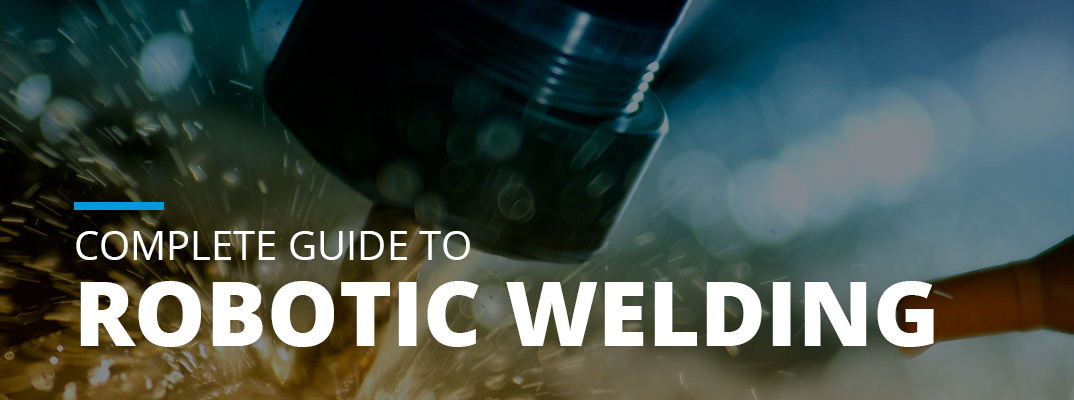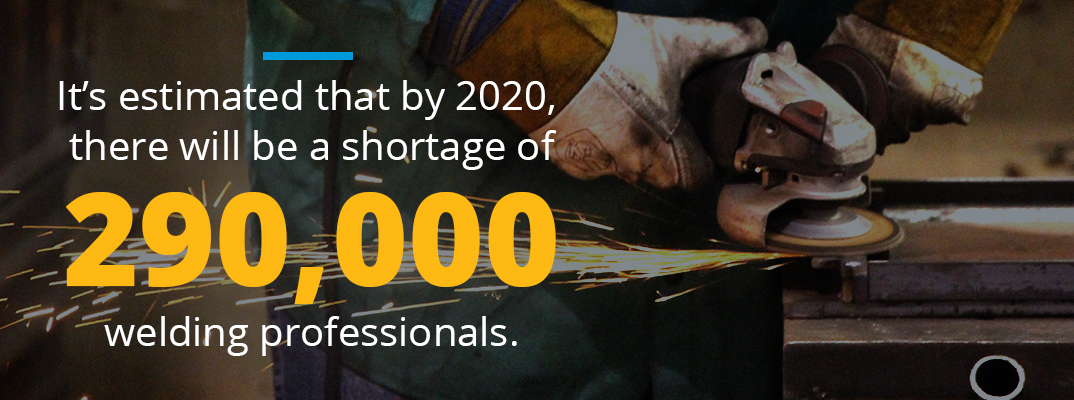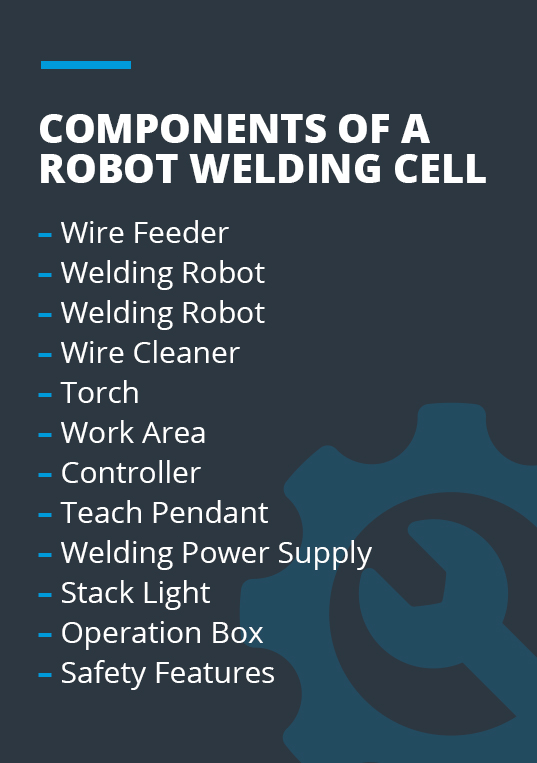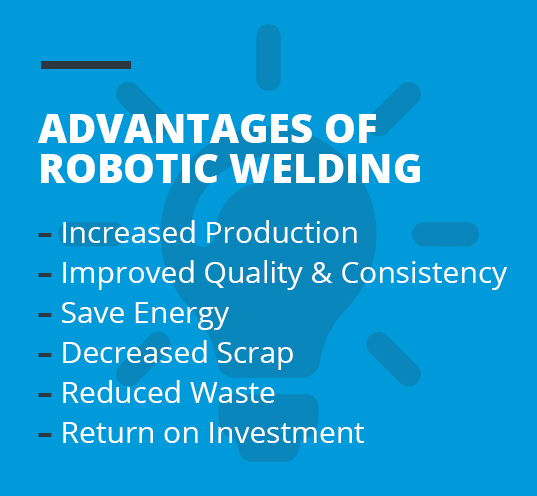
Updated 8/24/2023
In the manufacturing industry, companies constantly strive for improved quality and productivity while still keeping costs low. In order to make these improvements, manufacturing companies often turn to technology, and this is especially true in the case of welding.
Welding, at its most basic form, is the process of joining two materials through the application of heat and pressure. When people think of welding, the word often conjures an image of a protective mask and a pair of heavy gloves handling a torch. While manual welding still has its place in the industry, a growing shortage of professional welders has left a substantial gap. The American Welding Society estimates that by 2020, there will be a shortage of 290,000 welding professionals. An increasing number of companies are investing in robotic welding setups.
Installing a robotic welding apparatus takes a great deal of consideration, planning and significant investments in time and money. However, companies that have implemented robotic welding in their procedures have discovered innumerable long-term benefits.

If your company is considering the possibility of using robotic welding as part of your parts manufacturing process, here is a complete guide to what you need to know about the process, its history and its benefits.
Robotic welding, also called automated welding, is the automated process of using mechanized programmable tools to weld and handle a part. This relatively new application of robotics has filled the gap left by the growing shortage of welding professionals, effectively taking over a large portion of welding jobs the North American industry.
The history of robotic welding is deeply rooted in the history of industrial robots in general, going back to the mid-20th century.
The first programmable robot was invented in 1954 by George Devol, and Devol shortly followed up this invention with the establishment of the world’s first robot company, Unimation. With this new company, Devol and his associates created the first industrial robot. The model, called the Unimate, was used in a General Motors automobile factory in New Jersey, performing spot welding and extracting die castings. After this positive introduction, the concept of the industrial robot spread to all corners of the globe within a decade.
From this initial model, the industrial robot continued to improve. In 1978, Unimation, funded by General Motors, created the Programmable Universal Machine for Assembly, called the PUMA for short. Many labs still use this version today.
The industry continued to grow, booming in the early 80s. During these years, the industrial robot industry grew so rapidly that a new robot or company entered the market every month, increasing competition and innovation substantially. In this decade, robotic arms were improved to have more mobility and control.
Processes continued to improve throughout the 90s, with electronic controls improving to a point where multiple robots could be controlled and coordinated simultaneously. Operator interfaces were also improved, and robot designs were simplified and streamlined to allow more access for maintenance and repair.
Technological advancements continue to improve the functionality of industrial robots to this day, only limited by the costs of equipment and research.
A robot welding unit, also called a robot welding cell, consists of several components working together to weld pieces. These components include those actively taking part in the welding, as well as accessories and safety features to ensure the smooth operation of the cell.

Programs are input via the teach pendant and saved to the controller, which tells the robot what to do. These programs move the welding robot and manipulate the torch on the end of its arm, placing it exactly where it needs to be at any point. The torch heats up, using a power supply to generate enough heat in the metal to fuse parts together permanently. The wire feeder feeds extra material to the robot arm to do this. Between parts, the arm moves the torch to the wire cleaner to remove any spatter.
The work flow of a robotic welding cell consists of a series of closely monitored steps. These steps are:
1. Set the part into the fixture and clamp it securely into place.
2. Select the appropriate program from the controller. Alternatively, if the appropriate program is not available, program the controller using the teach pendant.
3. Push the start button on the controller to begin work.
4. As the first part is worked on, move the second part into the appropriate loading station.
5. As welding starts on the first work station, begin setting up the second work station.
6. When welding finishes, work will begin on the second station.
7. Collect the finished part from station 1 and reload the work station for the next cycle.
Specific functions and intricacies vary depending on the particular robotic welding cell used, but most will follow this general procedure.
Robotic welding makes up 29% of all robotic applications in industry, topped only by robotic material handling. Automatic welding is most commonly used in the manufacturing and engineering industries to increase the efficiency of companies and labs.
Most commonly, they are used for resistance spot welding and arc welding for high quantities of product. These two processes are described in detail below:
Robotic resistance welding is an economical way to weld two pieces of sheet metal together at a single point, or spot. This type of welding is commonly seen in the automobile manufacturing industry, where it is used to weld sheet metal into the form of a car. Many of the spot welders in the automobile industry are robotic and can be seen working on car assembly lines.
The spot welding process works by applying two copper alloy electrodes to the parts being fused and passing a current through the materials. The current heats the metal and causes it to melt, forming a pool between the pieces at the spot applied. Upon cooling, the pieces fuse together.
Robot welders are ideal for this application as they are able to place multiple spot welds with extreme accuracy and efficiency.
Robotic arc welding has grown as an industry only recently, but is quickly catching up to spot welding as the most popular robotic welding method. The process uses a power supply to generate an electric arc between a torch-mounted electrode and metal. This arc produces a temperature of about 6,500 degrees Fahrenheit at the tip of the torch. This heats up the metal, producing a pool of molten metal beneath the torch that solidifies upon cooling. Upon cooling, the parts permanently fuse together.
Because of the extremely high temperatures produced, the metals involved in this process will often react chemically with the oxygen and nitrogen in the surrounding air. This can compromise the integrity of the weld joint. For this reason, many arc-welding processes involve a process called arc shielding. This process covers the arc and the molten metal with a protective shield of gas or vapor, minimizing the contact between the molten metal and the surrounding air.
The extreme heat and chemical reactions involved in arc welding make it a perfect application for robotics, as this reduces the exposure of workers and operators to these risks.
 What Are the Advantages of Robotic Welding?
What Are the Advantages of Robotic Welding?Implementing a robotic welding setup requires a significant investment of time and funds. However, the benefits of the system far surpass the benefits of traditional welding, and the costs of the system are quickly earned back in increased productivity, improved quality and reduced waste.
Welding teams across the United States benefit from robotic welding because of the following benefits:
Robotic welding systems get the job done quickly and efficiently, making fewer mistakes than their human counterparts while increasing production speed tremendously. Additionally, robots can work 24/7, unlike human workers who require sleep, breaks and vacations. Human operators typically have less than 50% arc-on time, and human on-time percentages decrease as fatigue sets in later on in the shift. Robots, on the other hand, have 75%-80% arc-on time. This number increases to 95% for parts with longer seams.
The automated system creates consistent weldments with extremely close accuracy, placing the same quality welds in the same spot repeatedly without fatiguing. The precision of these systems also reduces spattering, resulting in neater seams. This does not eliminate mistakes and defects, however — malfunctioning or damaged equipment or incorrect programming can both result in product defects. Fortunately, both problems can be prevented by certified robotic welding technicians.
Automated welding systems conserve energy by running consistently, cutting the energy-expensive start-ups. Additionally, robots do not overweld and reduce the need for corrective welding, cutting energy expenditure.
Human error is always possible, even with the most skilled welders. However, every movement a welding robot makes is planned and automated, reducing mistakes and, therefore, reducing the number of scrapped parts. On higher-value jobs, this can be a crucial factor to staying on budget.
Consumables are yet another source of waste. Consumables include nozzles and other components with relatively short life spans that are replaced after a certain number of uses. Robotic welding units increase welding speed and minimize excess energy use, increasing the lifespan of each consumable component. This means new consumables are purchased less frequently, saving costs.
Most companies will find that for larger projects, the efficiencies, accuracy and cost savings of robotic welding – more than make up for the initial setup cost when working with a metal fabrication company.
The combination of greater speeds, higher-quality welds and decreased scrap all contribute to this quick return on investment. This return increases further when you consider the reduced energy costs and minimized chances of overwelding. Switching to a robotic welding process can help save the company significantly in overall costs.
To calculate an approximate return on investment, a company can assess current part cycle times and compare them with potential cycle times for a robotic welding setup. Other savings in waste, labor and energy can be tied into the estimate as well for a more accurate number.
Robotic welding will continue to set the standard for speed and efficiency in the global welding market. And as robotic welding technology continues to advance, more and more companies will use it in their manufacturing processes to save time and money.
While robots’ prominence may reduce the number of human workers, it won’t completely eliminate them, as humans are still more adaptive than robots. Robots will likely continue to be most popular in assembly lines where the work is very tedious. For more specialized services, humans will continue to have essential roles to play.
As more countries realize that robotic welding can help them remain competitive in the global market, robotic welding will only become more prominent. And as countries lean toward more sustainable, environmentally-friendly manufacturing practices, robotic welding offers a solution that improves energy efficiency for less environmental impact and greater profits.
A good contract manufacturer invests not only in highly trained professionals, but also in robotic welding setups that provide the best quality and value by monitoring MIG guns and consumables and seeking appropriate peripherals for the machine:
MIG guns must be selected carefully to suit the needs of the particular model being used in the robotic welding setup. Companies should choose MIG guns with the proper amperage and cooling capacity for the application. Inadequate amperage or cooling can cause the machine to fail, while purchasing a gun with more amperage capacity than necessary is a waste of money, as the price of a robotic MIG gun is directly proportional to the amperage it offers.
Consumables, such as contact tips, nozzles, retaining heads and liners, should also be selected and managed carefully. Different nozzles and contact tips should be selected for different applications — standard-duty consumables should be used for low-amperage applications or applications with shorter arc times, while heavy-duty consumables, which are more expensive than the standard versions, should be used for high-amperage or high-arc — time applications to reduce the amount of downtime needed to change them.
A peripheral is any piece of additional equipment that can be integrated into the robotic welding system. Using the right kind of peripherals can maximize the performance of the setup. Although peripherals come with an up-front cost, they can increase the return on the robot welding investment by improving the setup’s performance, increasing the lifetimes of consumables and reducing the likelihood of welding defects.
Some potentially helpful peripherals include:
All of these peripherals can aid in the protection and increased productivity of robotic welding equipment.
Robotic welding requires constant supervision and maintenance by a trained operator. If no one in the company’s current talent pool has prior robotic welding experience, it is in the company’s best interest to hire a metal fabrication company with certified robotic welding unit operators on staff.
A trained technician will be able to maximize uptime on the project, by scheduling and performing regular preventative maintenance on the system. This helps minimize unnecessary downtime and ensures the system runs smoothly – all benefits that are passed along to your project.
Hiring a contract manufacturer with certified robotic welding technicians may be a more cost-effective method. Very few companies specialize in robotic welding, especially within the United States, with a highly-trained, professional staff who know exactly how to work with robotic welding cells to produce the best results for your product. Caldera Manufacturing Group, formerly Fairlawn Tool, Inc., is one of these companies, providing quality robotic welding service to our customers by an AWS certified welding team.
At Caldera Manufacturing Group, we consider robotic welding to be an integral part of our production process to help reduce overall costs to our customers, helping you get the highest quality product at the lowest cost. Additionally, we also proudly offer manual welding services that are well suited to smaller run and highly custom commercial orders. In most cases, the manual welding can be combing with robotic welding to get the best of both approaches. We pride ourselves on consistent quality, no matter how large the manufacturing project, because we want to ensure each unit exceeds your expectations.
Caldera Manufacturing Group is a full service contract manufacturer for all of your metal fabrication needs. By handling every part of the process in house from our Maryland factory location, we are able to ensure the highest level of quality at a competitive price. We’re always happy to help answer any questions and consult on the best approach for your company.
Contact us today to speak with us about your upcoming metal fabrication projects.